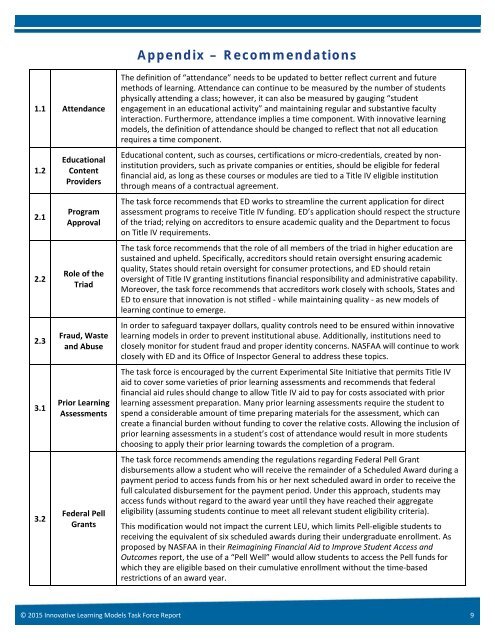INNOVATIVE LEARNING MODELS
Innovative_Learning_ModelsTFReport
Innovative_Learning_ModelsTFReport
Create successful ePaper yourself
Turn your PDF publications into a flip-book with our unique Google optimized e-Paper software.
Appendix – Recommendations1.1 Attendance1.22.12.22.33.13.2EducationalContentProvidersProgramApprovalRole of theTriadFraud, Wasteand AbusePrior LearningAssessmentsFederal PellGrantsThe definition of “attendance” needs to be updated to better reflect current and futuremethods of learning. Attendance can continue to be measured by the number of studentsphysically attending a class; however, it can also be measured by gauging “studentengagement in an educational activity” and maintaining regular and substantive facultyinteraction. Furthermore, attendance implies a time component. With innovative learningmodels, the definition of attendance should be changed to reflect that not all educationrequires a time component.Educational content, such as courses, certifications or micro-credentials, created by noninstitutionproviders, such as private companies or entities, should be eligible for federalfinancial aid, as long as these courses or modules are tied to a Title IV eligible institutionthrough means of a contractual agreement.The task force recommends that ED works to streamline the current application for directassessment programs to receive Title IV funding. ED’s application should respect the structureof the triad; relying on accreditors to ensure academic quality and the Department to focuson Title IV requirements.The task force recommends that the role of all members of the triad in higher education aresustained and upheld. Specifically, accreditors should retain oversight ensuring academicquality, States should retain oversight for consumer protections, and ED should retainoversight of Title IV granting institutions financial responsibility and administrative capability.Moreover, the task force recommends that accreditors work closely with schools, States andED to ensure that innovation is not stifled - while maintaining quality - as new models oflearning continue to emerge.In order to safeguard taxpayer dollars, quality controls need to be ensured within innovativelearning models in order to prevent institutional abuse. Additionally, institutions need toclosely monitor for student fraud and proper identity concerns. NASFAA will continue to workclosely with ED and its Office of Inspector General to address these topics.The task force is encouraged by the current Experimental Site Initiative that permits Title IVaid to cover some varieties of prior learning assessments and recommends that federalfinancial aid rules should change to allow Title IV aid to pay for costs associated with priorlearning assessment preparation. Many prior learning assessments require the student tospend a considerable amount of time preparing materials for the assessment, which cancreate a financial burden without funding to cover the relative costs. Allowing the inclusion ofprior learning assessments in a student’s cost of attendance would result in more studentschoosing to apply their prior learning towards the completion of a program.The task force recommends amending the regulations regarding Federal Pell Grantdisbursements allow a student who will receive the remainder of a Scheduled Award during apayment period to access funds from his or her next scheduled award in order to receive thefull calculated disbursement for the payment period. Under this approach, students mayaccess funds without regard to the award year until they have reached their aggregateeligibility (assuming students continue to meet all relevant student eligibility criteria).This modification would not impact the current LEU, which limits Pell-eligible students toreceiving the equivalent of six scheduled awards during their undergraduate enrollment. Asproposed by NASFAA in their Reimagining Financial Aid to Improve Student Access andOutcomes report, the use of a “Pell Well” would allow students to access the Pell funds forwhich they are eligible based on their cumulative enrollment without the time-basedrestrictions of an award year.© 2015 Innovative Learning Models Task Force Report 9



